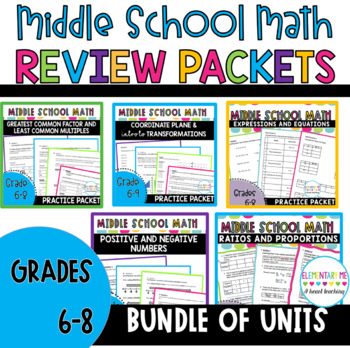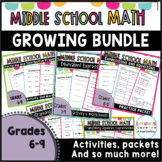6th and 7th Grade Math Review Skill Packets Bundle
- Zip
Products in this Bundle (6)
showing 1-5 of 6 products
Also included in
- Save money and engage your middle school math students with this GROWING BUNDLE of high-quality math resources. Products cover a range of topics including algebraic expressions, ratios, proportions, the distributive property, order of operations, percents, and more. The bundle includes activities, gPrice $83.20Original Price $104.00Save $20.80
Description
6th and 7th Grade Math Review / Summer Packets Bundle
Looking for a good way to review 6th grade math concepts with your students? This math review packet covers many of the major topics taught in 6th and 7th grade math: fractions, decimals, one-step equations, ratios and proportion. It is great for 6th grade math students, 7th grade math students, those entering pre-algebra who need a review, RTI interventions, small groups, scaffolded whole group instruction, test prep and reteaching. Also makes a wonderful addition to summer packets for students entering 7th and 8th grade.
These review packets cover:
- all four operations with decimals, including order of operations with decimals
- all four operations with fractions & mixed numbers
- ratios, rates, & unit rates
- converting fractions, decimals, and percent
- finding the percent of a number
- comparing integers & absolute value
- graphing in the coordinate plane (all 4 quadrants)
- evaluating algebraic expressions
- solving one-step equations
- problem solving
The packets contain a vocabulary section, scaffolded notes section and extra practice on topics pages. This review packet makes an excellent summer math packet for rising 7th grade and 8th grade students but it would also be a great September back to school review or reteach for students entering pre-algebra, as well as good practice and review of concepts before state testing for any middle school student!
Not interested in the whole bundle? Grab the packets one at a time! Or find other activities linked to the reviewed skills in my store.
- Middle School Math Equations and Expressions Review Packet
- Middle School Math Emergency Sub Plans Order of Operations and One Step Equations
- Middle School Math Graphing Inequalities on a Numberline
- Middle School Math Equivalent Expressions Activity
- Middle School Math Equivalent Fractions, Decimals, and Percents Activity
- Middle School Math Order of Operations Activity {PEMDAS}
Need a review packet on a different level?



